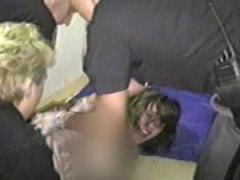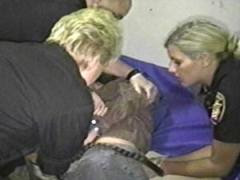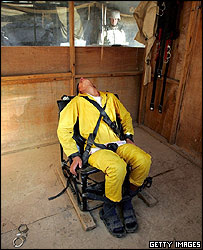Wednesday, February 6, 2008
The Torture State’s Domestic Face
An additional note: Literally
minutes after I posted this essay, the embedded videos of Hope Steffey’s molestation were removed from YouTube due to a copyright claim by the television station that originally aired them. The video is still available here.
This sort of thing isn’t supposed to happen — at least not to attractive, middle-class, middle-aged American women.
We’ve become at least somewhat inured to the spectacle of sadistic violence being inflicted on dusky-skinned foreign terrorist suspects, or the occasional (make that “increasingly frequent”) violent death of black Americans, both young males and elderly women, as a result of paramilitary police raids.
Some of us have read the complaints of accused criminals who have been “lit up” by corrections officers in jails or brutalized in prison. And it’s not difficult to find accounts of similar treatment inflicted on illegal aliens held in ICE detention facilities (the most notorious of which was built with the help of illegal immigrant labor, of course).
But, hey – the perps had it coming, right? And why should we be upset if some border-jumper gets roughed up a bit? After all, isn’t that how things are done al otro lado de la frontera?
Hearts unmoved by such cases tend to melt at the spectacle of a slender, helpless woman shrieking in fear and impotent rage as she is pinned down and violently disrobed by skinheads wearing the uniform of Ohio’s Stark County Sheriff’s Department.
Don’t get me wrong: The outrage over the sexual violation of Ohio resident Hope Steffey, who was arrested, assaulted by police, strip-searched, and left naked in a cell for six hours, is eminently justified.
In fact, I earnestly hope that there will be much more outrage, that it goes thermonuclear, and that its radiating consequences include not only criminal charges against the simians in uniform who violated Hope, but also a dramatic increase in public curiosity about the routine sadism, perversion, and abuse that typify America’s prison-industrial complex.
It must be understood that what happened to Hope – who was arrested after suffering an assault and calling the police for help – is uncommon only in that the abuse she suffered was inflicted on an uncommonly telegenic and sympathetic victim. Fury over her experience in jail is coupled with outrage that this woman could begin the night as the victim of a private assault and end it as a victim of sexual molestation and battery under color of authority. And she was taken to jail on the flimsiest of pretexts, being arrested for resisting arrest – a tautological police tactic that is becoming increasingly common.
But what we have to remember is that Hope’s evening from hell is not that unusual. In fact, her case isn’t even unique for Ohio’s Stark County jail system.
Last August, three teenage girls from Canton, Ohio filed suit against the Multi-County Juvenile Attention Center after a “scared straight” experience turned into a festival of sexual assault and humiliation.
In April of last year, the girls were charged with “criminal trespass on a public sidewalk” — a charge as contrived as an arrest for resisting arrest – as a result of a fight that involved several other teenagers. The girls insist that they were innocent bystanders, a predictable claim that has the merit of being legally true: Rather than going to court, the girls agreed to perform 20 hours of “community service,” attend school dutifully, and take a 15-minute “walk-through” of the juvenile “Attention Center.”
According to the lawsuit, within minutes of their arrival at the juvenile jail, a “youth leader” — that is, a guard – began to scream at them. When the girls reacted by giggling, a predictable adolescent reaction to tension, the tax-engorged cretin assaulted them, throwing them against the wall face-first while continuing to scream at them.
Led to the second floor of the facility, the girls were subjected to crude and denigrating sexual remarks. One guard – who should be fitted for a millstone (these are 13-year-old girls we’re talking about) or at least beaten into jelly by the male relatives of his victims – made remarks about the girls’ breasts. Another insinuated that one of the girls was a lesbian and displayed his unique charm by cracking a funny about that reliable comic staple, prison rape: “[The] other female inmates will love you because they love blondes.”
Female guards then took the girls individually into a room where each of them was forced to strip and undergo a body cavity examination – while the male guards prowled just outside the doorway making derisive remarks. The girls were then forced to put on filthy jail attire – including unlaundered intimate wear. About a half-hour later they were given 30 seconds to change their clothes under the threat of staying in the jail overnight.
The girls then fled. The guards went back to “work” until their shifts ended and they could go back to surfing the ‘Net for child porn, or whatever it is that skeevy, mouth-breathing degenerates of this sort do when they’re not on the clock.
When the parents complained to the court about the sexual violation and physical battery endured by their daughters, Court Administrator Richard DeHeer parried the complaint by replying…
… let’s all say it together …
… that the juvenile jail staff “acted within its protocol.”
This was essentially the same reaction Stark County Sheriff Tim Swanson offered when the strip-search and sexual violation of Hope Steffey hit the local news.
First of all, insisted Swanson, his deputies acted in accordance with established policies – despite the fact that the Department’s guidelines do not permit male deputies to be present when a female is being subjected to a strip search. Well, ah, y’see, what was done to Steffey wasn’t a strip search, Swanson continued.
This leaves to the imagination of those unusually gifted in the art of conjuring euphemisms to devise a more suitable way of describing a procedure that involved tearing the clothes and undergarments from a terrified, resisting woman, leaving her, you know, naked and forcing her to swaddle herself in toilet paper to provide some scintilla of modesty, since she was still very much within eyeshot of the tonsured steroid junkies who had held her down and torn off her clothes.
Hope and her husband have likewise filed suit. And, like the lawsuit filed on behalf of the three teenage girls from Canton, Hope’s complaint will never go to court. Some anodyne “reforms” will be promised, or a useless “administrative inquiry” will be undertaken; nobody who draws a tax-funded paycheck will be punished in any way; a tax-subsidized settlement will be reached, and business as usual will continue behind bars in Stark County.
And this means that, as surely as water will wet us, and as surely as fire will burn, other innocent people in Stark County will be abducted under color of authority, on the basis of entirely contrived charges, and suffer treatment similar to that received by Hope Steffey.
The real source of outrage here is that things could have been so much worse for Hope. Yes, she could have been forced to “ride the Taser,” had the arresting officer been interested in giving her a brief taste of electrocution torture. But in many jurisdictions, an arrestee who struggled as Hope did to preserve her personal dignity may have been confined in a bizarre retro-medievalist apparatus called a “restraint chair.”
Restraint chairs come in various styles, colors, and brand names, but the design and function are consistent: The device binds an inmate in such a way that he or she cannot move the arms, legs, or torso.
Purportedly created for the sole purpose of restraining violent and dangerous inmates to prevent them from injuring themselves or others, restraint chairs have been used for punishment, despite explicit warnings from manufacturers. The result has been a growing number of incidents in which prisoners – including non-violent offenders and arrestees yet to be convicted of any offense – have been abused, maimed, crippled, tortured, and killed.
Writing in the April 2000 issue of The Progressive* (obviously a left-leaning journal, but one of the few publications that takes the Bill of Rights seriously), Ann-Marie Cusac recites a list of restraint chair abuses that have been documented in lawsuits and official investigations:
*the devices have been used “for punishment of nonviolent behavior”; for instance, protesters arrested on disorderly conduct charges have been confined in the chair for passive resistance to orders from guards, or for demanding to speak to lawyers;
*children have been “strapped into the chairs for nonviolent behaviors”: Dan Corcoran, president of a Beaverton, Oregon firm that manufactures the chairs, reported under oath that his biggest clients included juvenile detention systems in Georgia and Florida;
*“nude inmates and detainees have been strapped into restraint chairs”;
*some prisoners have been confined to the chairs for as long as eight days;
*other prisoners have been “hooded, pepper-gassed, beaten, or threatened with electrocution” while shackled to the chairs – treatment we’d now associate with the “enhanced interrogation techniques” (that is, torture) used against foreign terrorist suspects.
*as of 2000, at least eleven people died while confined in restraint chairs, often from positional asphyxia, blood clots, or cardiac arrest. Several of those episodes involved inmates or arrestees with documented and treatable mental illness.

A little more than a decade ago, tax-feeding thugs in the employ of Arizona’s Maricopa County Sheriff’s Office confined Richard Post, a wheelchair-bound paraplegic, to a restraint chair. Post, who became a competitive wheelchair athlete after the 1985 car accident that crippled his legs, had been arrested for possessing a gram of marijuana.
While in the holding cell, Post tried to explain that he needed an internal catheter in order to urinate; this is an important medical necessity for a paraplegic, and one that could have been accommodated with little difficulty. But Post was in the custody of a department headed by Joe Arpaio, a waddling sack of corrupt ego who uses the calculated abuse of detainees to cultivate an image as “America’s toughest sheriff.” The chair-moisteners employed by Arpaio weren’t interested in helping Post, so the desperate man started to rattle his cage and flush the toilet in protest.
That was not dangerous behavior, however annoying it might have been. Yet several of Arpaio’s heroes seized the helpless paraplegic and confined him in a restraint chair, cinching down the straps with such force that they broke his neck. Already deprived of his legs, Post lost the use of his hands. He sued the County – one of many to do so as a result of criminal abuse or the death of a loved one at the hands of Arpaio’s trained simians — and received an $800,000 settlement.
In 1999, the Sacramento Sheriff’s Department paid out $755,000 to dismiss a class-action suit over the use of restraint chairs as punishment. Among the plaintiffs in the suit was Katherine Martin, a 106-pound woman with a heart condition who was confined to a chair for eight and a half hours after allegedly touching a guard. The restraints were pulled so tight that skin was permanently abraded from Katherine’s back and shoulders, and she suffered lasting nerve damage. As is often the case when detainees are confined in the chair for long periods, Katherine was denied access to a bathroom and spent hours sitting in her own waste.
The charge against Katherine that led to this treatment was “suspicion of public drunkenness.”
Ronald Motz, another plaintiff in the Sacramento lawsuit, was also arrested for public drunkenness. A videotaped record shows Motz pleading for a chance to call his attorney, only to be told by a guard that “the phone doesn’t work.” After a gap in the tape, Motz is shown being strapped down in a chair with a spit mask around his face.
“I just want to call my attorney,” he protests.
“You don’t get to call an attorney,” snaps a guard, who informs him that he was “going to be released in about five hours. Now you’re not.”
“What did I do wrong – ask for my attorney?” Motz asks plaintively.
“You weren’t following directions,” the guard replies.
The Sacramento video record also shows the March 1999 detention of a woman named Gena Domogio, who was strapped in a chair after being thrown to the floor by several guards who knelt on her back and wrapped her face in a towel. As she is bound into the chair she can be heard protesting that she had a thyroid problem and couldn’t breathe. Kimberly Bird, another Sacramento detainee, was taken to the hospital after being rendered unconscious in the chair. The video record shows her pleading, “I’m going to die. Don’t let me die.”
As a result of lawsuits in Phoenix, Sacramento, Utah, and elsewhere, the use of restraint chairs has tapered off somewhat in recent years, at least domestically. Oh, they’re still in use, of course: The Sacramento Sheriff’s Department, for instance, faces another potential lawsuit over using the chair as a punish-and-torture mechanism. But the lawsuits of a decade ago apparently caused at least some agencies to lose some of their enthusiasm for the device.
A burgeoning overseas market: An insurgent or terrorist suspect is held in a restraint chair by US military forces.
While markets for the device have been hard to find in Europe and in most of the English-speaking world, Corcoran (who was deposed in the Sacramento lawsuit) was able to unload large part of his inventory in such havens of liberty and human dignity as the United Arab Emirates. Since “interrogating prisoners” is one of the advertised functions of the chairs, Corcoran probably found a good customer in the CIA and the Department of Homeland Security.
Of course, the experiences of Hope Steffey and the three anonymous teenage girls from Canton demonstrate that no hardware is needed to terrorize and traumatize people who shouldn’t be behind bars to begin with – people who are completely innocent or charged with non-violent offenses. And it’s a certainty that somewhere, today, in this “free” country’s prison population, the largest in the world – seven million people either behind bars, in prison, or on parole — we could find plentiful examples of entirely harmless people who are being denigrated, abused, terrorized, and tortured in ways that would make Hope Steffey’s experience look playful.
A brief postscript….
Several of my friends are employed as prison guards, or deputy sheriffs in charge of jail inmates. I attend church with one, correspond with others, receive regular friendly visits from a third, and respect all of them. The problem, obviously, is not that everyone who works for the prison-industrial complex is a depraved, sadistic lout; the problem is that the Regime — through the idiotic fraud called the “war on drugs” and the criminalization of vices and behaviors that should not be crimes — has created a prison population several times larger than it should be, and devised perverse profit incentives for economically depressed communities to go into the business of incarceration. If we build them — prisons — “they” will come, both inmates and guards, in such numbers that we will inevitably see an increase in the population of genuinely depraved “detention officers” and administrators.
*The Progressive is published in Madison, Wisconsin; the magazine that once employed me is published in Appleton, a couple of hours north of that city. On a few occasions I ran into reporters from that journal and found that — our ideological disagreements notwithstanding — we shared many of the same concerns about the emerging Homeland Security State.
A reminder: My book Liberty in Eclipse: The War on Terror and the Rise of the Homeland Security State is now available.
Dum spiro, pugno!
Content retrieved from: http://freedominourtime.blogspot.com/2008/02/torture-states-domestic-face.html.






